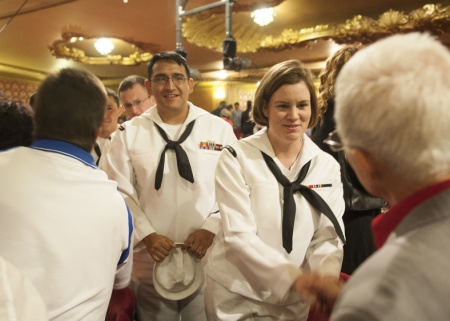There are reasonably good answers to this question on both the Air Force and Navy websites, including basic qualifications. The short version is:
- Become an officer in the Air Force or Navy/Marines.
- Apply and get accepted into pilot training.
- Compete for a fighter pilot slot.
- Complete the fighter portion of training.
There are no fighter pilots in the Army or Coast Guard. Marine Corps pilots wear Navy wings.
The Air Force and Navy have similar means by which you can become a fighter pilot. In general, you must first become an officer, either by attending one of the service academies, completing ROTC, or graduating from Officer Training/Candidate School (OTS/OCS). In most cases, just prior to your commissioning you will be able to request what your desired job will be. If you select and receive the opportunity to become a pilot, you will then have to attend Undergraduate Pilot Training (UPT).
You may get a “pilot slot,” but, in most cases, you will not know whether you will fly helicopters, heavies, or fighters until well into pilot training in both the Navy and Air Force (except in rare circumstances, or if you are a Guard/Reserve pilot).
(The Navy doesn’t technically fly “heavies,” per se, like the KC-135, though it does fly several large, non-fighter aircraft including C-130s (Marines), E-6s, and a variety of other patrol and cargo aircraft.)
Prior to UPT, you may have to attend a flight screening program. The Air Force currently conducts Initial Flight Screening (IFS) at Pueblo, Colorado.
In the Air Force, you will have to complete the first 3-4 months of pilot training before your class is split into those who will fly fighters, heavies, and helicopters. Your ability to get the fighter track (T-38s) will depend on your relative class ranking, your instructors’ input, the needs of the Air Force (how many of each type of pilot they need), and the desires of your classmates. For example, if the Air Force needs more C-130 pilots than F-15 pilots, your class might get 2 fighter slots and 10 heavy slots. On the other hand, you could be ranked #10 in your class, but if the 9 guys in front of you want to fly heavies, then you’ll get the chance to fly a fighter.
If you do choose and receive the fighter track, near the completion of the T-38 course you will be given the opportunity to rank-order the fighters you would like to fly. The jet that you get will depend on your class rank, the input of your instructors, the needs of the Air Force, and the desires of your classmates (See a pattern?). For example, the Air Force may need 8 F-16 pilots but no F-15 pilots, meaning you won’t be able to get an F-15 even if its your first choice. It is also worth noting that the Air Force has alternately put bombers into/out of the T-38 track, meaning that you could complete T-38s and end up flying a B-52. The location of bombers (fighter vs. heavy track) has oscillated over the years. At one point, even UAVs were assigned out of the T-38 track.
After you graduate pilot training you will need to complete your survival training and pass the centrifuge. Your next course will be IFF, which is taught in T-38s. After you graduate IFF, you will then go through the basic course (B-Course) for your fighter.
Once you complete the B-course, you will transfer to an operational unit. Depending on what jet you go to, you will then go through another 2 to 6 month upgrade. At the completion of that upgrade you will be a “Mission Ready” (MR) wingman, able to fly on the wing of a more experienced pilot into combat.
On average, in the Air Force it takes 2 years from the start of pilot training to being a “true” fighter pilot.
In the Navy, you attend Officer Candidate School (OCS) in Pensacola, Florida, followed by a six week “Air Indoctrination” course. Primary flight training follows (6 months at Whiting or Corpus Christi), and the split track occurs after initial flight training. Intermediate flight training builds on navigation, and advanced training is mission specific. Wings are awarded after advanced training. Pilots then go to Fleet Replacement Squadrons (FRS) to learn their specific aircraft.
For questions regarding Ed Rush’s Fighter Pilot Power Pack (an aid to becoming a fighter pilot), see this commentary.
 An
An 
